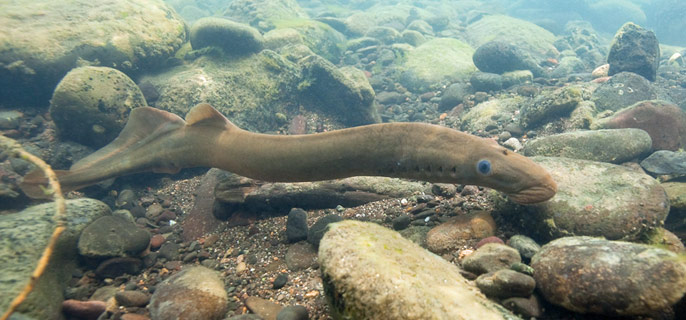
PHOTO COURTESY OF ODFW
Pacific lampreys migrating up the Columbia River will find their route past McNary Lock and Dam a bit easier to travel, thanks to a prototype lamprey-passage structure installed in the downstream end of the Oregon shore fish ladder, U.S. Army Corps of Engineers officials announced on Thursday.
The 40-feet-long structure, fabricated in several sections, was installed during the past week. In August 2013, Marine Industrial Construction of Wilsonville was awarded a $336,542 contract to build, deliver and install the device.
Lampreys belong to a primitive group of fishes that are eel-like in form, but lack the jaws and paired fins of typical fishes. Lampreys have a round sucker-like mouth, no scales and breathing holes instead of gills.
“Lampreys are very important to the health of the inland aquatic ecosystem,” said Corps Project Manager Mark Smith. “As larvae, they’re the vacuum cleaners of our streams and rivers, spending the first four to seven years of their lives in freshwater, filter-feeding among the sands and fine silt.”
Although not formally protected as an ESA-listed species, lamprey abundance has diminished in the Columbia Basin during the past 30 years. Lampreys are anadromous — migrating from fresh to ocean waters and returning to spawn — and were once common in the Snake, Clearwater and Salmon river drainages.
As adults migrating to ocean environment, Pacific lampreys become parasitic and feed on a variety of salt-water prey. After two to three years, they stop feeding and return to the freshwater rivers and streams to spawn, said Smith. Lampreys are also culturally significant to the Pacific Northwest tribes who use these fish for food and medicine.

PHOTO COURTESY OF U.S. ARMY CORPS OF ENGINEERS
In May 2008, the Corps of Engineers entered into agreements with the other action agencies (the Bonneville Power Administration and the Bureau of Reclamation), four tribes and one state for 10-year commitments to benefit fish, particularly Columbia River Basin salmon and steelhead stocks. Those agreements, known as the Columbia Basin Fish Accords, later expanded to include a total of seven tribes and three states. As part of those agreements, the Corps committed to plans and actions designed to improve lamprey passage.
Lamprey-passage modifications at dams are critical to improving their mobility up the rivers to reach spawning areas. Although the Columbia Basin Fish Accords put lampreys on the Corps’ radar as a species that needed help to pass the dams, much is yet unknown about which in-water conditions best accommodate these unique fish. The new McNary lamprey-passage structure is fitted with pit-tag detectors at both ends. The one-foot-high flume between the entrance and exit contains circle- and half-circle-shaped baffles to produce a range of reduced water velocities across the width of the structure’s interior.
“We plan to conduct video monitoring to observe which velocity is preferred by migrating lampreys,” said Smith. “We anticipate this prototype structure will help us learn quite a bit about what’s best for lamprey passage.” Tagging operations at Bonneville and John Day dams will help researchers track lampreys as they pass through the structure.
The McNary prototype is the latest of many modifications made to fish ladders at Corps dams to improve lamprey-passage conditions without negatively affecting fish passage. At Walla Walla District dams on the Snake and Columbia rivers – McNary, Ice Harbor, Lower Monumental, Little Goose and Lower Granite – metal plating attached along ladder floors and lamprey-friendly pass-through orifices in weirs provide smoother surfaces for lampreys to attach to as they move upstream. Corps dams in the Portland District on the Columbia River – John Day, The Dalles and Bonneville – have also made modifications to improve conditions for lampreys in their fish passage facilities.








